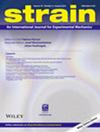砂浆弯曲裂缝黏聚区模型识别研究
IF 2.4
3区 材料科学
Q2 MATERIALS SCIENCE, CHARACTERIZATION & TESTING
引用次数: 9
摘要
本文提出了一种利用数字图像相关提取的灰度残差来定义单边缘缺口试样中弯曲裂纹路径的方法,然后对内聚区模型的参数进行校准。通过对有限元模型的修正,使代价函数最小化,只考虑实验力。位移和灰度残差场允许对校准参数进行验证。最后,将结果与直裂纹给出的结果进行比较,以突出考虑实际裂纹路径的好处。本文章由计算机程序翻译,如有差异,请以英文原文为准。
On the identification of cohesive zone model for curved crack in mortar
This paper proposes an approach to defining the path of a curved crack in a single‐edge notched specimen with gray level residuals extracted from digital image correlation, followed by the calibration of the parameters of a cohesive zone model. Only the experimental force is used in the cost function minimized via finite element model updating. The displacement and gray level residual fields allow for the validation of the calibrated parameters. Last, the results are confronted with those given by a straight crack to highlight the benefits of accounting for the actual crack path.
求助全文
通过发布文献求助,成功后即可免费获取论文全文。
去求助
来源期刊

Strain
工程技术-材料科学:表征与测试
CiteScore
4.10
自引率
4.80%
发文量
27
期刊介绍:
Strain is an international journal that contains contributions from leading-edge research on the measurement of the mechanical behaviour of structures and systems. Strain only accepts contributions with sufficient novelty in the design, implementation, and/or validation of experimental methodologies to characterize materials, structures, and systems; i.e. contributions that are limited to the application of established methodologies are outside of the scope of the journal. The journal includes papers from all engineering disciplines that deal with material behaviour and degradation under load, structural design and measurement techniques. Although the thrust of the journal is experimental, numerical simulations and validation are included in the coverage.
Strain welcomes papers that deal with novel work in the following areas:
experimental techniques
non-destructive evaluation techniques
numerical analysis, simulation and validation
residual stress measurement techniques
design of composite structures and components
impact behaviour of materials and structures
signal and image processing
transducer and sensor design
structural health monitoring
biomechanics
extreme environment
micro- and nano-scale testing method.
 求助内容:
求助内容: 应助结果提醒方式:
应助结果提醒方式:


